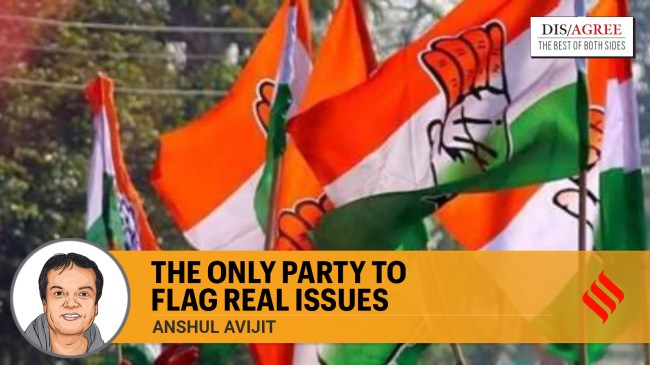Opinion Best of both sides | Anshul Avijit writes: Congress is the only party that flags real issues
The grand old party is not infallible. But dealing with asymmetrical electoral battles is difficult
 There is a perception among some that Congress has lost ground, given its performance in three of the four assembly elections since June 2024.
There is a perception among some that Congress has lost ground, given its performance in three of the four assembly elections since June 2024. There were sneering comments that when Congress got nearly 100 seats in the Lok Sabha elections, it was rejoicing like it had crossed the majority mark. This certainly wasn’t the case, though doubling its seat count on the back of a powerful ideological pitch was certainly motivating. The hubris of the BJP, which was claiming it would cross 400 seats, was also cut down to size by the electorate.
Congress’s concern was a real one: The threat of the architecture of social justice and the load-bearing policy of reservation being hollowed out of the Constitution would be all the more imminent if the BJP had increased its tally. Moves like removing references to caste prejudice from NCERT textbooks also made it seem like the stage was being set to undermine reservation. After all, if there has been no historical discrimination, there are no measures required to correct it. Nine months after the general elections, and particularly after the lateral entry threat and the Waqf Board amendments, these dangers remain as critical now.
Congress’s electoral gain was also because of the terrifying failures of Modinomics. A robust GDP growth of well over 7 per cent in 2014 was Congress’ gift to the new regime. However, the Modi government quickly squandered it. Demonetisation was the kiss of death — it caused growth to plummet and reduced demand. GST, hastily passed under the cover of darkness, added to the woes. Employment and inflation soared, particularly after the mismanagement of Covid and it was Congress’s relentless highlighting of economic suffering as well as crony capitalism that undoubtedly spoke to the voters. One often says that in India, there is a non-linear relationship between economic trauma and voting patterns. It is more likely that this kind of suffering is silent — it can certainly be felt but is not always disclosed. Modinomics has for long managed to capitalise on this. It no longer can.
There is a perception among some that Congress has lost ground, given its performance in three of the four assembly elections since June 2024. This needs some correction. Why does the Prime Minister, on the very evening of his party’s triumph, single out the Congress for sarcastic denouncements? There is a clear paranoia that the Indian reality — about the economy, social injustice, incompetence and deception — will catch up. The PM’s constant targeting of the Congress shows just how much the latter matters.
Jharkhand’s voters gave an emphatic result where Gathbandhan allies covered each other’s weaknesses and played on their strengths. The BJP, in true Orwellian style, tried its best to poison the well but the people would have none of it. The fear was that the tribal plurality was going to be consumed by monolithic religious codes. With a contribution of 16 seats of the 56 in the 81-member house, Congress could hardly be called a millstone around its allies’ necks — the beloved cliche of its critics.
The BJP+ win in Maharashtra and the reversal in Haryana surprised pundits and pollsters alike. The issue of the Election Commission’s opacity around 39 lakh new voters being added before the polls remains unaddressed. In Haryana, infighting was a factor. That said, the voteshare difference between Congress and the BJP was minuscule. Congress continues to have a significant presence in both these states.
Delhi was more complex. Three ducks in a row is unthinkable for a party that had ruled the state for three consecutive terms. There is no easy vindication here. However, AAP’s dramatic rise and fall is instructive — and the latter is precisely the reason Congress will regain lost ground. AAP had its origins in “anti-politics” — a kitschy mockery of the political class was seen in the rallies in its formative years. In reality, it later became apparent that this hostility masked an obsessive desire to belong to the very categories it tore down. AAP also resonated with the middle class because the party leveraged its success as ahistorical, autonomous and self-earned, while a vast majority of Delhi’s underprivileged were attracted to the narrative of “political betrayal”.
However, AAP’s not-too-subtle majoritarianism exposed the fragility of this self-image. The CAA protests and the Delhi riots became a completely no-go site for fear of being blacklisted in the Hindu imaginary. The charges of palaces and profiteering sealed the hypocrisy. AAP’s avowed “anarchism”, its initial war cry, was an attempt to blindside the establishment and build an alternative politics for the disaffected. It did succeed for more than a decade. This time, it was swallowed by a party that was far better, and more vicious, at both betrayal and deceit.
The BJP is almost its mirror image with many of the AAP’s attributes except that its resolve to etch social and religious fault lines is unmatched.
Congress is not infallible. There are allegations of complacency and smugness, and more serious ones of neglect and organisational impairment. They can be dealt with, as every party does. The trust of the people can also be regained, like in Telangana. It can even surmount asymmetrical electoral battles, where state institutions are complicit in determining outcomes. This is because Congress is an idea that is even bigger than the party. It is an idea that has traversed 140 years — from spearheading the fight against colonialism to building the nation. It cannot be contained in just 100 seats or be written off after a few electoral blips. The Prime Minister, and all its critics, know that only too well.
The writer is national spokesperson of Congress




